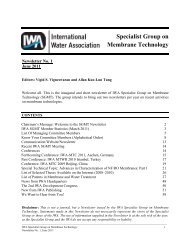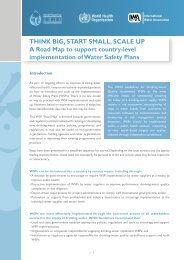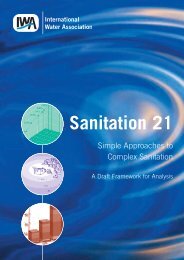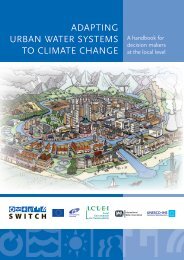Water and Energy - Draft Report of the GWRC Research ... - IWA
Water and Energy - Draft Report of the GWRC Research ... - IWA
Water and Energy - Draft Report of the GWRC Research ... - IWA
You also want an ePaper? Increase the reach of your titles
YUMPU automatically turns print PDFs into web optimized ePapers that Google loves.
Organisation: WSAA & CRC WQT<br />
Contact person: Tony Priestly (CSIRO)<br />
Email address: Tony.Priestley@csiro.au<br />
<strong>Energy</strong> Consumption in <strong>the</strong> Provision <strong>of</strong> Urban <strong>Water</strong> Services<br />
Why Local Conditions Matter<br />
Introduction<br />
The provision <strong>of</strong> urban water services in Australia is a major undertaking involving businesses<br />
with an annual turnover in excess <strong>of</strong> $6 billion. Pressure is mounting on <strong>the</strong> volumes <strong>of</strong> water<br />
available for use in urban areas <strong>and</strong> questions are being asked as to <strong>the</strong> long term sustainability<br />
<strong>of</strong> water supply to Australia’s growing urban communities. A key aspect <strong>of</strong> any consideration <strong>of</strong><br />
sustainability issues involves energy consumption. In <strong>the</strong>ory, if abundant energy is available at a<br />
relatively cheap price <strong>and</strong> with no long term environmental limitations, <strong>the</strong>n Australian cities<br />
have no water crisis. Seawater desalination is an essentially inexhaustible supply, so long as <strong>the</strong><br />
energy required can be sourced. Of course, <strong>the</strong> reality is that energy supplies are not<br />
inexhaustible <strong>and</strong> climate change is imposing a shadow over <strong>the</strong> cheaper sources <strong>of</strong> power such<br />
as coal.<br />
This study looks at <strong>the</strong> use <strong>of</strong> energy to provide urban water services in some <strong>of</strong> <strong>the</strong> major urban<br />
centres in Australia <strong>and</strong> seeks to underst<strong>and</strong> <strong>the</strong> drivers behind <strong>the</strong> variations in observed energy<br />
consumptions. In doing so, it will contribute to <strong>the</strong> debate on <strong>the</strong> sustainability <strong>of</strong> urban water<br />
systems <strong>and</strong> allow comparisons to be made with alternative design approaches.<br />
<strong>Energy</strong> Use in Urban <strong>Water</strong> Systems<br />
<strong>Water</strong> is an essential underpinning <strong>of</strong> any civilization <strong>and</strong> has long history <strong>of</strong> use in urban areas<br />
dating back to Roman times. Urban water services entail <strong>the</strong> provision <strong>of</strong> a safe water supply for<br />
a range <strong>of</strong> uses including drinking, washing, food preparation, garden watering, waste disposal<br />
<strong>and</strong> a range <strong>of</strong> commercial <strong>and</strong> industrial needs. The services also include <strong>the</strong> disposal <strong>of</strong><br />
wastewater <strong>and</strong> <strong>the</strong> management <strong>of</strong> stormwater, encompassing what has become known as <strong>the</strong><br />
urban water cycle. In general, <strong>the</strong>re is very little public underst<strong>and</strong>ing <strong>of</strong> <strong>the</strong> enormous resources<br />
required to provide <strong>the</strong>se services <strong>and</strong> certainly no knowledge <strong>of</strong> <strong>the</strong> energy consumption<br />
implications.<br />
Tables 1 <strong>and</strong> 1A below provide a detailed breakdown <strong>of</strong> energy consumption for four <strong>of</strong><br />
Australia’s major urban areas, Sydney, Perth, Melbourne <strong>and</strong> Brisbane. Analysis <strong>of</strong> this data<br />
provides some underst<strong>and</strong>ing <strong>of</strong> what drives energy consumption in <strong>the</strong> provision <strong>of</strong> urban water<br />
services. <strong>Energy</strong> consumption in <strong>the</strong> form <strong>of</strong> both electricity <strong>and</strong> natural gas for water supply <strong>and</strong><br />
waste disposal is outlined <strong>and</strong>, in some cases, broken down into energy consumed in pumping<br />
<strong>and</strong> treatment.<br />
The data paint an interesting picture across <strong>the</strong> different cities <strong>and</strong> highlight <strong>the</strong> fact that local<br />
geography, topography <strong>and</strong> environmental regulations play a major role in determining energy<br />
consumption. An important point to note is that, despite water authorities being major energy<br />
<strong>GWRC</strong> <strong>Water</strong> & <strong>Energy</strong> - <strong>Draft</strong> report<br />
67

















